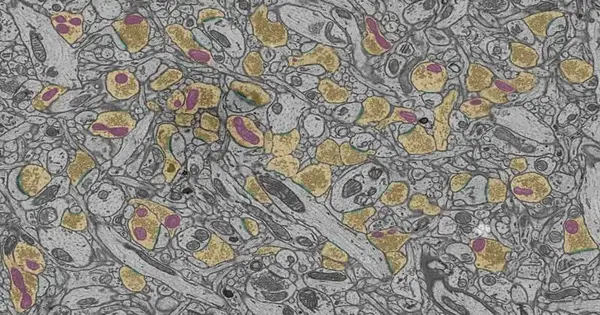A lot of nested and dependent pieces are needed for the brain to function properly, much like a puzzle. Each of the areas that make up the brain has millions of neurons connected by tens of thousands of synapses. Even more minute structures called message-sending boutons, message-receiving dendrites (complementary branch-like structures for receiving bouton messages), and power-producing mitochondria are all necessary for these synapses, which allow communication between neurons. Message-sending boutons are swollen bulbs at the tips of neurons that resemble branches. All of these components must be present for the brain to function properly.
These pieces, however, can become misplaced or altered as we age and no longer fit into the overall picture of the brain. A study on this subject has just been released by a research team in the journal Frontiers in Aging Neuroscience.
“Fifty percent of people experience loss of working memory as they age, which means their ability to hold and manipulate information in the short term diminishes,”
Courtney Glavis-Bloom, a senior staff scientist in Salk Institute Professor John Reynolds’s lab.
According to Courtney Glavis-Bloom, a senior staff scientist in Professor John Reynolds’s lab at the Salk Institute and a co-first author of the study, “Fifty percent of people experience loss of working memory with old age, meaning their ability to hold and manipulate information in the short term decreases.”. “We set out to discover why some people age with healthy working memory while others do not. We also learned a brand-new synaptic mechanism for cognitive impairment during this process.”.
As people age, their brains lose synapses, and the researchers observed this pattern in their non-human primate model. However, when they examined the remaining synapses, they discovered evidence of a breakdown in the coordination between the size of boutons and the mitochondria they held.
The ultrastructural size principle, a cornerstone of neuroscientific theory, states that whenever one component of the synaptic complex changes in size, all other components must as well. Synapses, mitochondria, and boutons must all scale with one another. Prior to the Salk team’s study, nobody had considered whether age or illness could violate this principle.
Co-first author Casey Vanderlip, a former research assistant in Reynolds’s lab, says, “To examine this, we turned to electron microscopy.”. “This allowed us to see these components across numerous synapses. Both healthy and impaired aging resulted in synaptic loss, but what was different was the breakdown in the relationship between the sizes of boutons and their mitochondria.
According to Glavis-Bloom, the change in neural networks, brain activity, and behavior is the result of “an enormously small synaptic structure.”. Researching these microscopic dysfunctions is uncharted territory that has the potential to fundamentally alter how we think about aging and how it affects cognition.
The synaptic complex’s various components typically expand and contract together. The researchers discovered proof that this process can become dysfunctional with aging, which may result in cognitive impairment. The Salk Institute is the source.
In order to prevent working memory decline with aging, the team discovered that adherence to the ultrastructural size principle was crucial. The study marks the beginning of a new era in the study of aging by emphasizing the violation of the ultrastructural size principle and mitochondrial failures as the causes of age-related cognitive impairment.
According to Reynolds, who holds the Fiona and Sanjay Jha Chair in Neuroscience, the synapses we have photographed are snapshots of a dynamic process. “With these snapshots in hand, we can start to consider the mechanisms that coordinate the growth and contraction of the various synaptic complex components and then consider how disruption of these mechanisms can account for age-related cognitive decline. This offers a completely fresh perspective on cognitive decline and may suggest new therapeutic targets in the future.
Sammy Weiser Novak and Uri Manor of the Salk Institute, as well as Masaaki Kuwajima, Lyndsey Kirk, and Kristen M. Harris of the University of Texas at Austin, are additional authors.
More information: Violation of the ultrastructural size principle in the dorsolateral prefrontal cortex underlies working memory impairment in the aged common marmoset (Callithrix jacchus), Frontiers in Aging Neuroscience (2023). DOI: 10.3389/fnagi.2023.1146245





